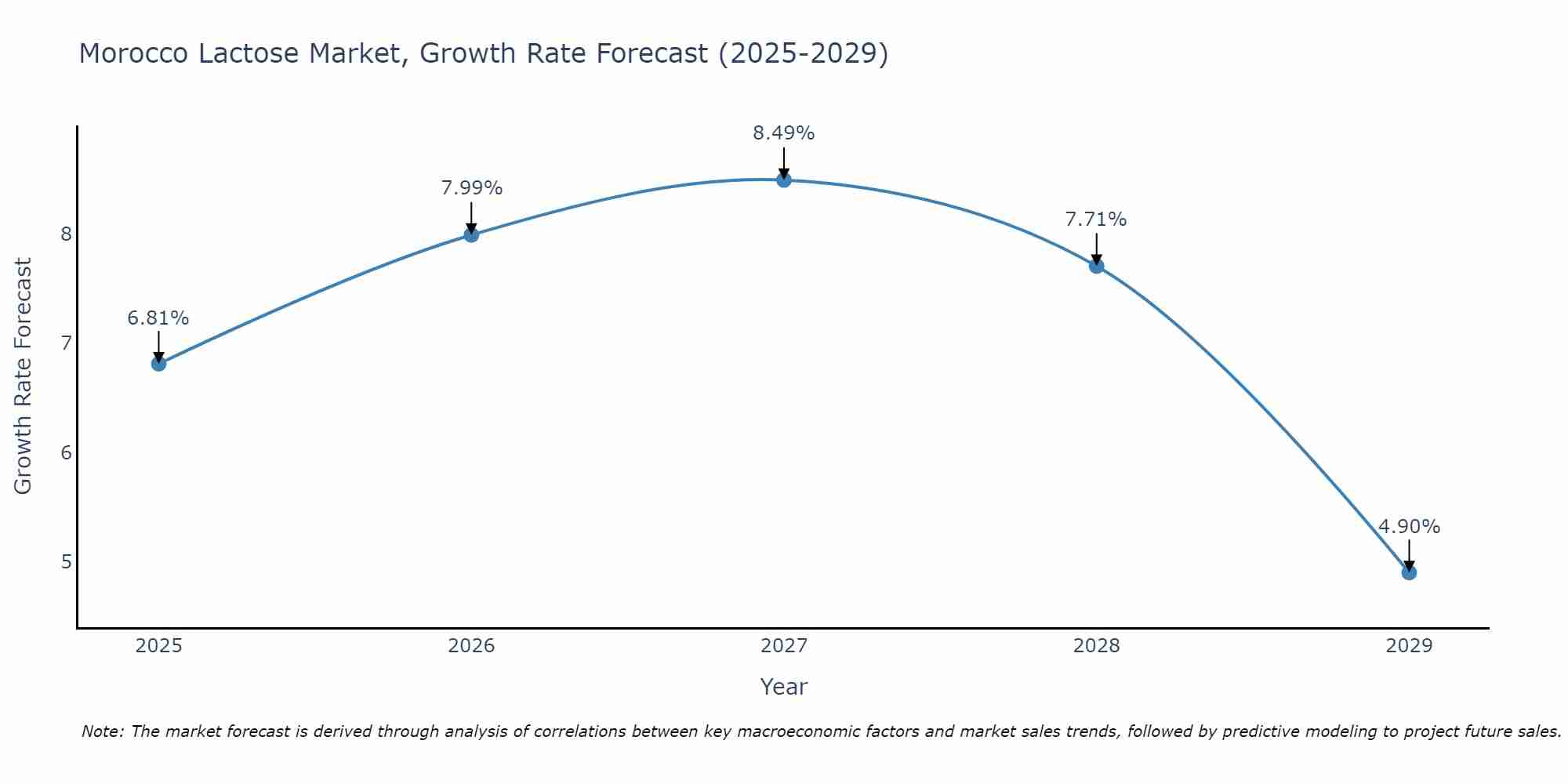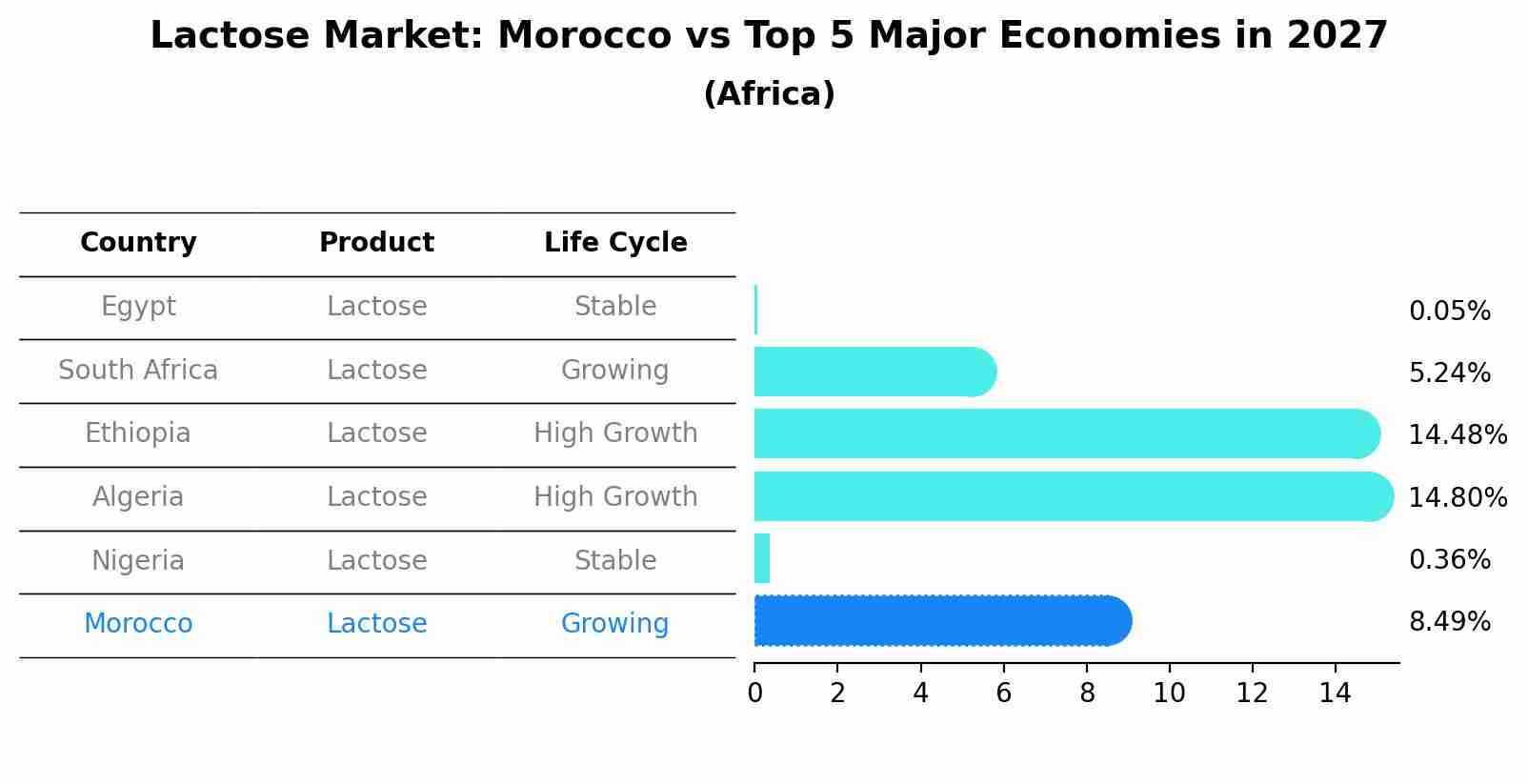Morocco Lactose Market Outlook | Size, Forecast, Revenue, Trends, Share, Companies, Analysis, Value, Growth, Industry & COVID-19 IMPACT
| Product Code: ETC090312 | Publication Date: Jun 2021 | Updated Date: Apr 2025 | Product Type: Report | |
| Publisher: 6Wresearch | Author: Ravi Bhandari | No. of Pages: 70 | No. of Figures: 35 | No. of Tables: 5 |
Morocco Lactose Market Size Growth Rate
The Morocco Lactose Market is projected to witness mixed growth rate patterns during 2025 to 2029. The growth rate begins at 6.81% in 2025, climbs to a high of 8.49% in 2027, and moderates to 4.90% by 2029.

Lactose Market: Morocco vs Top 5 Major Economies in 2027 (Africa)
The Lactose market in Morocco is projected to grow at a growing growth rate of 8.49% by 2027, within the Africa region led by Egypt, along with other countries like South Africa, Ethiopia, Algeria and Nigeria, collectively shaping a dynamic and evolving market environment driven by innovation and increasing adoption of emerging technologies.

Morocco Lactose Market Synopsis
The Lactose market in Morocco supplies milk sugar derived from whey or milk, used as a sweetener, binder, and bulking agent in food and pharmaceutical products. Lactose is widely used in confectionery, bakery, dairy, and pharmaceutical formulations for its sweetness, solubility, and texture-modifying properties. It serves as a carrier for flavors, colors, and active ingredients in food and pharmaceutical applications, contributing to product quality and sensory attributes. With the diverse applications of lactose in the food and pharmaceutical industries, the market in Morocco offers various grades and forms of lactose to meet the needs of manufacturers and consumers.
Drivers of the market
The Morocco Lactose Market is driven by the increasing demand for lactose in various applications such as food and beverages, pharmaceuticals, and animal feed. Lactose is used as a sweetener, stabilizer, and filler in food products and pharmaceuticals. The growth of the food and beverage industry, coupled with rising demand for functional and fortified foods, fuels market demand. Additionally, the use of lactose in dairy products, confectionery, and nutritional supplements supports market growth.
Challenges of the market
In the Morocco Lactose Market, challenges arise from shifting consumer preferences, regulatory compliance, and market competition. Lactose, a sugar derived from milk, is used as a sweetening agent and excipient in pharmaceuticals and food products. However, addressing concerns regarding lactose intolerance and dairy allergies may impact market demand. Moreover, ensuring compliance with regulatory standards for lactose purity and quality adds complexity to market operations. Additionally, competing with alternative sweeteners and sugar substitutes presents challenges for market growth. Furthermore, managing supply chain logistics and addressing price volatility in dairy markets pose additional challenges for market players operating in the Morocco market.
Government Policy of the market
To support the lactose market, the Morocco government implements policies that bolster the dairy industry and address lactose intolerance challenges. Incentives include subsidies for dairy farmers to improve lactose-free milk production, funding for research on lactose alternatives, and initiatives to promote lactose-free products in the food and beverage sector. The government also works to educate consumers about lactose intolerance management and fosters innovation in lactose-free food technologies.
Key Highlights of the Report:
- Morocco Lactose Market Outlook
- Market Size of Morocco Lactose Market, 2024
- Forecast of Morocco Lactose Market, 2031
- Historical Data and Forecast of Morocco Lactose Revenues & Volume for the Period 2018 - 2031
- Morocco Lactose Market Trend Evolution
- Morocco Lactose Market Drivers and Challenges
- Morocco Lactose Price Trends
- Morocco Lactose Porter's Five Forces
- Morocco Lactose Industry Life Cycle
- Historical Data and Forecast of Morocco Lactose Market Revenues & Volume By Form for the Period 2018 - 2031
- Historical Data and Forecast of Morocco Lactose Market Revenues & Volume By Powder for the Period 2018 - 2031
- Historical Data and Forecast of Morocco Lactose Market Revenues & Volume By Granule for the Period 2018 - 2031
- Historical Data and Forecast of Morocco Lactose Market Revenues & Volume By Application for the Period 2018 - 2031
- Historical Data and Forecast of Morocco Lactose Market Revenues & Volume By Food and Beverages for the Period 2018 - 2031
- Historical Data and Forecast of Morocco Lactose Market Revenues & Volume By Confectionery for the Period 2018 - 2031
- Historical Data and Forecast of Morocco Lactose Market Revenues & Volume By Animal Feed for the Period 2018 - 2031
- Historical Data and Forecast of Morocco Lactose Market Revenues & Volume By Pharmaceutical for the Period 2018 - 2031
- Historical Data and Forecast of Morocco Lactose Market Revenues & Volume By Cosmetics for the Period 2018 - 2031
- Historical Data and Forecast of Morocco Lactose Market Revenues & Volume By Others for the Period 2018 - 2031
- Morocco Lactose Import Export Trade Statistics
- Market Opportunity Assessment By Form
- Market Opportunity Assessment By Application
- Morocco Lactose Top Companies Market Share
- Morocco Lactose Competitive Benchmarking By Technical and Operational Parameters
- Morocco Lactose Company Profiles
- Morocco Lactose Key Strategic Recommendations
Frequently Asked Questions About the Market Study (FAQs):
1 Executive Summary |
2 Introduction |
2.1 Key Highlights of the Report |
2.2 Report Description |
2.3 Market Scope & Segmentation |
2.4 Research Methodology |
2.5 Assumptions |
3 Morocco Lactose Market Overview |
3.1 Morocco Country Macro Economic Indicators |
3.2 Morocco Lactose Market Revenues & Volume, 2021 & 2031F |
3.3 Morocco Lactose Market - Industry Life Cycle |
3.4 Morocco Lactose Market - Porter's Five Forces |
3.5 Morocco Lactose Market Revenues & Volume Share, By Form, 2021 & 2031F |
3.6 Morocco Lactose Market Revenues & Volume Share, By Application, 2021 & 2031F |
4 Morocco Lactose Market Dynamics |
4.1 Impact Analysis |
4.2 Market Drivers |
4.3 Market Restraints |
5 Morocco Lactose Market Trends |
6 Morocco Lactose Market, By Types |
6.1 Morocco Lactose Market, By Form |
6.1.1 Overview and Analysis |
6.1.2 Morocco Lactose Market Revenues & Volume, By Form, 2021-2031F |
6.1.3 Morocco Lactose Market Revenues & Volume, By Powder, 2021-2031F |
6.1.4 Morocco Lactose Market Revenues & Volume, By Granule, 2021-2031F |
6.2 Morocco Lactose Market, By Application |
6.2.1 Overview and Analysis |
6.2.2 Morocco Lactose Market Revenues & Volume, By Food and Beverages, 2021-2031F |
6.2.3 Morocco Lactose Market Revenues & Volume, By Confectionery, 2021-2031F |
6.2.4 Morocco Lactose Market Revenues & Volume, By Animal Feed, 2021-2031F |
6.2.5 Morocco Lactose Market Revenues & Volume, By Pharmaceutical, 2021-2031F |
6.2.6 Morocco Lactose Market Revenues & Volume, By Cosmetics , 2021-2031F |
6.2.7 Morocco Lactose Market Revenues & Volume, By Others, 2021-2031F |
7 Morocco Lactose Market Import-Export Trade Statistics |
7.1 Morocco Lactose Market Export to Major Countries |
7.2 Morocco Lactose Market Imports from Major Countries |
8 Morocco Lactose Market Key Performance Indicators |
9 Morocco Lactose Market - Opportunity Assessment |
9.1 Morocco Lactose Market Opportunity Assessment, By Form, 2021 & 2031F |
9.2 Morocco Lactose Market Opportunity Assessment, By Application, 2021 & 2031F |
10 Morocco Lactose Market - Competitive Landscape |
10.1 Morocco Lactose Market Revenue Share, By Companies, 2024 |
10.2 Morocco Lactose Market Competitive Benchmarking, By Operating and Technical Parameters |
11 Company Profiles |
12 Recommendations |
13 Disclaimer |
- Single User License$ 1,995
- Department License$ 2,400
- Site License$ 3,120
- Global License$ 3,795
Search
Related Reports
- Portugal Occupational Health & Safety Services Market (2025-2031) | Strategy, Consumer Insights, Analysis, Investment Trends, Opportunities, Growth, Size, Share, Industry, Revenue, Segments, Value, Segmentation, Supply, Forecast, Restraints, Outlook, Competition, Drivers, Trends, Demand, Pricing Analysis, Competitive, Strategic Insights, Companies, Challenges
- Netherlands Occupational Health and Safety Services Market (2025-2031) | Strategy, Consumer Insights, Analysis, Investment Trends, Opportunities, Growth, Size, Share, Industry, Revenue, Segments, Value, Segmentation, Supply, Forecast, Restraints, Outlook, Competition, Drivers, Trends, Demand, Pricing Analysis, Competitive, Strategic Insights, Companies, Challenges
- Belgium and Luxembourg Facility Management Market (2025-2031) | Strategy, Consumer Insights, Analysis, Investment Trends, Opportunities, Growth, Size, Share, Industry, Revenue, Segments, Value, Segmentation, Supply, Forecast, Restraints, Outlook, Competition, Drivers, Trends, Demand, Pricing Analysis, Competitive, Strategic Insights, Companies, Challenges
- Russia Women Intimate Apparel Market (2025-2031) | Strategy, Consumer Insights, Analysis, Investment Trends, Opportunities, Growth, Size, Share, Industry, Revenue, Segments, Value, Segmentation, Supply, Forecast, Restraints, Outlook, Competition, Drivers, Trends, Demand, Pricing Analysis, Competitive, Strategic Insights, Companies, Challenges
- Africa Chocolate Market (2025-2031) | Size, Share, Trends, Growth, Revenue, Analysis, Forecast, industry & Outlook
- Global Hydroxychloroquine And Chloroquine Market (2025-2031) | Industry, Trends, Size, Outlook, Growth, Value, Companies, Revenue, Analysis, Share, Forecast
- Saudi Arabia Plant Maintenance Market (2025-2031) | Industry, Size, Growth, Revenue, Value, Companies, Forecast, Analysis, Share & Trends
- Taiwan Electric Truck Market (2025-2031) | Outlook, Industry, Revenue, Size, Forecast, Growth, Analysis, Share, Companies, Value & Trends
- South Korea Electric Bus Market (2025-2031) | Outlook, Industry, Companies, Analysis, Size, Revenue, Value, Forecast, Trends, Growth & Share
- Africa Low Temperature Powder Coating Market (2025-2031) | Companies, Competition, Size, Challenges, Segmentation, Trends, Competitive, Industry, Supply, Strategy, Investment Trends, Growth, Segments, Restraints, Strategic Insights, Revenue, Share, Forecast, Drivers, Analysis, Pricing Analysis, Demand, Consumer Insights, Value, Opportunities, Outlook
Industry Events and Analyst Meet
Our Clients
Whitepaper
- Middle East & Africa Commercial Security Market Click here to view more.
- Middle East & Africa Fire Safety Systems & Equipment Market Click here to view more.
- GCC Drone Market Click here to view more.
- Middle East Lighting Fixture Market Click here to view more.
- GCC Physical & Perimeter Security Market Click here to view more.
6WResearch In News
- Doha a strategic location for EV manufacturing hub: IPA Qatar
- Demand for luxury TVs surging in the GCC, says Samsung
- Empowering Growth: The Thriving Journey of Bangladesh’s Cable Industry
- Demand for luxury TVs surging in the GCC, says Samsung
- Video call with a traditional healer? Once unthinkable, it’s now common in South Africa
- Intelligent Buildings To Smooth GCC’s Path To Net Zero













